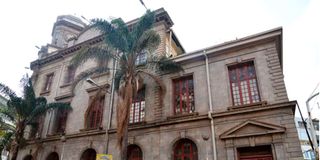Celebrating over a century of Ismaili community in Kenya

Town Jamatkhana (Khoja Mosque) on Moi Avenue, Nairobi. The iconic religious and cultural centre marks its 100th anniversary on January 14, 2022.
What you need to know:
- The Ismailis, mainly migrants from the State of Gujarat in India, arrived to settle in Nairobi around 1900.
- Town Jamatkhana was gazetted as a historic monument under the National Museums of Kenya in 2001.
The majestic iconic Town Jamatkhana (religious and cultural centre), popularly known as Khoja Mosque, a landmark on Moi Avenue in Nairobi’s Central Business District, first opened its doors on January 14, 1922.
Its 100-year anniversary provides an opportunity to reflect on how such a monument symbolises the permanence of the Ismaili Muslim Community in Kenya, as well as catalyses the development of a neighbourhood, a city, indeed a nation.
Construction of the three-storeyed Victorian-style building commenced in 1920. The foyer features magnificent arches and moulded ceilings; an atrium floods the space with natural light; balustrades are finished in handcrafted timber; panelled timber doors sit in arched frames; many floors are finished in patterned terrazzo; and windows, some with stained glass patterns, are supported by timber frames.
Over time, the building, comprising prayer halls as well as spaces for social events and learning, has supported religious and social activities of the Ismailis.
The Ismailis, mainly migrants from the State of Gujarat in India, had arrived to settle in Nairobi around 1900. About the same time, following completion of the construction of the Kenya-Uganda Railway, Indian tradespeople from Kenya’s Coast made their way inland and settled in Nairobi. Town Jamatkhana became the focal point of new businesses and is credited with stimulating the growth of Bazaar Street, now Biashara (Kiswahili for trade/commerce) Street.
History of Ismailis in Nairobi
Town Jamatkhana became an anchor and had a significant impact on the history and settlement of Ismailis in Nairobi, in both colonial and post-colonial times. As the community grew, the lack of access to education, health and financial services for multi-ethnic populations spurred the establishment of Aga Khan schools and hospitals, as well as Diamond Trust Bank and the Jubilee Insurance Company, to serve these segments of society.
These early initiatives and others since led to the formation, by His Highness the Aga Khan, of the Aga Khan Development Network (AKDN) — a group of 10 social, economic and cultural agencies covering education, healthcare, social development, hospitality, financial services, industry, infrastructure, property development, media services, culture and the environment, all working together to improve the quality of life of Ismailis and those among whom they live, regardless of gender, ethnicity or religion.
During the post-independence years, AKDN continued to support the development of the country, through activities such as manufacturing by Industrial Promotion Services (IPS) to reduce imports, and the establishment of Serena Lodges and Hotels, for tourists to bring in much-needed foreign currency.
Not far from the Jamatkhana, construction of the iconic 12-storey IPS Building on Kimathi Street began in 1967 — the tallest building in Nairobi at the time. Since then, also on Kimathi Street, The Nation Centre, another icon, opened in 1997. These stimulated further commercial development around them.
Historic monument
Town Jamatkhana was gazetted as a historic monument under the National Museums of Kenya in 2001. It soon created an opportunity for an ambassadorial building from which the Aga Khan Council (governance body of the Ismailis) and the Diplomatic Office of the AKDN could host exhibitions and cultural events; and bring together stakeholders from Government, the diplomatic corps, international partners, the private sector and the public to share knowledge and discuss key current issues and matters impacting our lives and the country.
Examples of public events include a concert by musicians from Afghanistan and Tajikistan (part of the Aga Khan Music Initiative); Rays of Light exhibition to commemorate the Aga Khan’s Diamond Jubilee; a discussion by key media houses on the future of media in a digital era; and a discussion on how we could preserve our natural assets while building our economy, presided over by Mr Keriako Tobiko, Cabinet Secretary for Environment, Prince Hussain Aga Khan and Princess Fareen Aga Khan.
Others include a workshop on the environment, chaired by Prince Rahim Aga Khan and involving UNEP, diplomats and academia; Fragile Beauty, an exhibition of Prince Hussain Aga Khan’s marine photography to raise awareness about the conservation of marine ecosystems (viewed by some 4,000 people); and an exhibition covering AKDN’s work in 14 African countries.
Today, a century since its opening, Town Jamatkhana continues to symbolise the permanent settlement of the Ismaili community in the country, alongside marking the community’s, as well as the AKDN’s, ongoing commitment towards improving the quality of life of all Kenyans.
Dr Azim is the Diplomatic Representative of the Aga Khan Development Network (AKDN).
Mrs Dostmohamed is the President of the Aga Khan Council.





